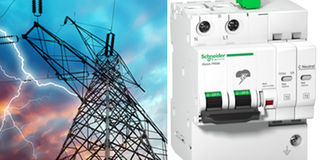Essential electrical safety for your home
Sponsored by Schneider Electric

We use dozens of appliances and devices daily without thinking about the electrical systems that power them. But don’t assume yours is safe. Many electrical fire risks are in plain sight, arising from factors such as old appliances, counterfeits, faulty outlets or even frayed electrical cords.
One of the very serious consequences of using substandard electrical products in your home is an arc fault. This is a high-power discharge of electricity between conductors. The discharge generates heat, which can break down the wire's insulation and trigger an electrical fire. These damages can occur anywhere in your home’s electrical system.
As a leading manufacturer of electrical equipment and power monitoring solutions, it is the duty of Schneider Electric to help train and educate electrical professionals on the best practices and technologies available to prevent fires before they start.
You can protect your family and substantially reduce your risk of tragedy caused by electrical accidents by taking a few minutes to check the following five components of your home’s electrical system.
Circuit breakers
Your electrical panel is the heart of your home’s electrical system. Modern homes use 63amp to 200amp circuit breakers to accommodate more and higher-power-consumption appliances.
Generally, in the case of power connection, the electricity goes through a circuit breaker box where it is divided into numerous circuits. Once circuit breakers are installed, they help in controlling the sudden rise of current and voltage that can damage your equipment or appliance.

Breaker panels have a lifespan of 25-30 years. If yours is older than that, it likely has deteriorating components and fewer circuits than can handle your electrical usage. It should be inspected by a licensed electrician to determine if it needs to be updated. There is a broad range of circuit breakers available, which depend upon the voltage, installation, external design, placement, and breaking mechanism.
Electrocution protection
While you’re inspecting your electrical panel, make sure it has installed at least one device that protects against electrical shock from faulty appliances or direct contact with live electrical equipment. Called a Ground Fault Circuit Interrupter (GFCI) or a Residual Current Device (RCD), this device measures the difference between how much power is flowing into the circuit and how much is flowing out. If it detects an imbalance, it recognises that current is leaking and immediately shuts off the circuit to prevent electrocution.

Outlets and switches
In addition to your electrical panel, make sure all the outlets and switches in your home are in good working order. Any that are cracked, broken, or loose should be replaced. Buzzing or discoloration indicates a wiring problem that needs professional attention.

Appliances and electronic devices
Don’t forget to check all your household appliances and devices. Frayed cords and damaged plugs are one of the biggest causes of electrical shock and house fires. Stop using and replace any appliance showing these types of wear.
By designing and installing electrical systems in compliance with all applicable standards, choosing the appropriate protective devices, vigilantly monitoring for potential risk conditions, and following maintenance best practices, the occurrence of electrical fires can be significantly reduced. Schneider Electric offers leading technology, solutions, and services to support you at every step.
Learn more to keep your family safe by accessing additional information on home electrical safety.
Most importantly, ensure you buy genuine Schneider Electric products from our authorised distributors and resellers.


